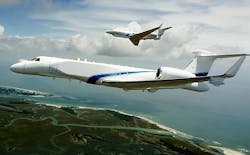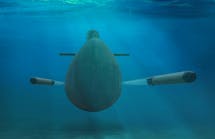Raytheon to provide telemetry and transmitter avionics for new Navy G550 test range aircraft
RIDGECREST, Calif. – U.S. Navy flight test experts needed a tri-band telemetry system and command transmitteravionics for a modified Gulfstream G550 business jet to enable the aircraft to act as the Navy's new Telemetry Range Support Aircraft (TRSA). They found their solution from The Raytheon Co. Missile Systems segment in Albuquerque, N.M.
Officials of the Naval Air Warfare Center Weapons Division at China Lake Naval Air Weapons Station in Ridgecrest, Calif., announced a $79.7 million contract Wednesday to Raytheon Missile Systems to build and install the telemetry system and transmitter on a modified Gulfstream G550.
The segment of Raytheon Missile Systems handling the work formerly was Ktech Corp., which Raytheon acquired in 2011. For the G550 aircraft Raytheon will build and install the Commercial Aircraft Based Instrumentation Telemetry System (CBITS) and the Airborne Command Transmitter System (ACTS) on the modified G550 TRSA aircraft.
This new aircraft will replace the Navy's NP-3D Orion aircraft primarily for operations on the Navy's 36,000-square-mile ocean test range northwest of Los Angeles for missile test support such as radar and visual safety surveillance; telemetry data collection and retransmission; time, space, and position information; high-resolution optical collections; and general fleet support. The aircraft also could be deployed for testing worldwide.
The NP-3D aircraft needs to be replaced because of significant service life, sustainment challenges, and obsolescence of the telemetry system, Navy officials say.
Today the Navy operates five NP-3Ds, which are based at Point Mugu Naval Air Station, Calif. The G550 TRSA aircraft will replace the NP-3D in Air Test and Evaluation Squadron 30 at Point Mugu NAS, which the Navy uses for telemetry range support.
This contract to Raytheon is part of a two-phase project to create the G550 TRSA aircraft to replace the NP-3D. In March 2016 the Navy bought a G550 from Gulfstream Aerospace in Savannah, Ga., which came with airborne early warning structural mold line modifications, mission systems provisions, and a Federal Aviation Administration Type Certificate.
The commercial variant of the Gulfstream G550 can seat as many as nine passengers, flies as fast as 590 knots at altitudes as high as 51,000 feet, and can fly as far as 6,750 miles without refueling.
The Navy's G550 TRSA version is modified with an enlarged nose, tail and side fairings; cable conduits and channels; interior layout; and a liquid cooling system.
Related: Time to invest in test and measurement tools
Now Raytheon will develop and build the CBITS and ACTS, and install them aboard the modified G550 TRSA aircraft for airborne data retrieval functions, Navy officials say.
During a typical telemetry mission, the aircraft flies near missiles, aircraft, or other systems under test and collects data through the telemetry antennas. The systems record the data and relay it back to ground test ranges for further analysis. The aircraft itself will have six crew stations in the cabin with consoles for mission system operators.
The CBITS will require two or three antennas covering about 100 square feet mounted to the side of the G550 TRSA fuselage. Additional line of sight radios and satellite communications will also be added for voice and data transmission.
On this contract Raytheon will do the work in Albuquerque, N.M., and should be finished in February 2022. For more information contact the Raytheon Missile Systems Ktech division online at www.raytheon.com, or the Naval Air Warfare Center Weapons Division-China Lake at www.navair.navy.mil/nawcwd/command/Navy.aspx.
Ready to make a purchase? Search the Military & Aerospace Electronics Buyer's Guide for companies, new products, press releases, and videos

John Keller | Editor
John Keller is editor-in-chief of Military & Aerospace Electronics magazine, which provides extensive coverage and analysis of enabling electronic and optoelectronic technologies in military, space, and commercial aviation applications. A member of the Military & Aerospace Electronics staff since the magazine's founding in 1989, Mr. Keller took over as chief editor in 1995.



